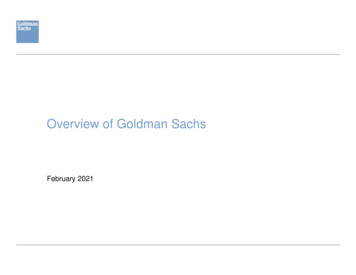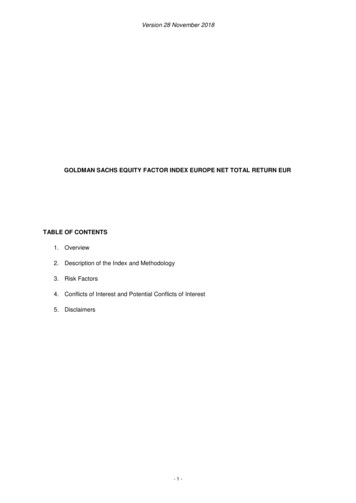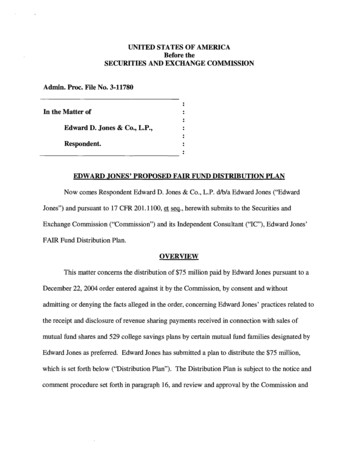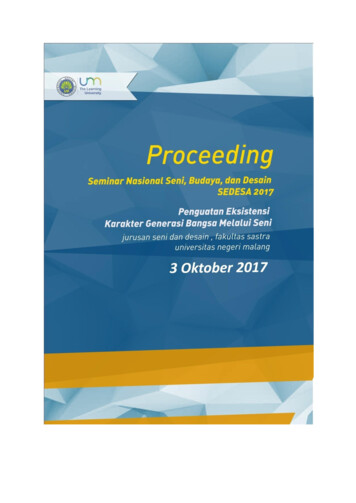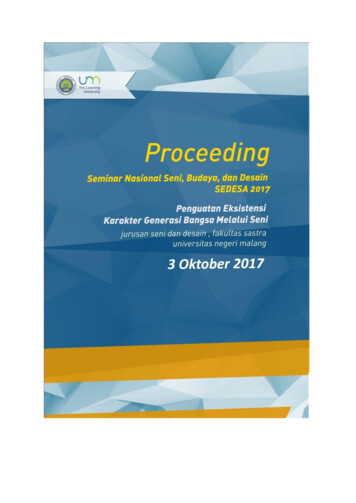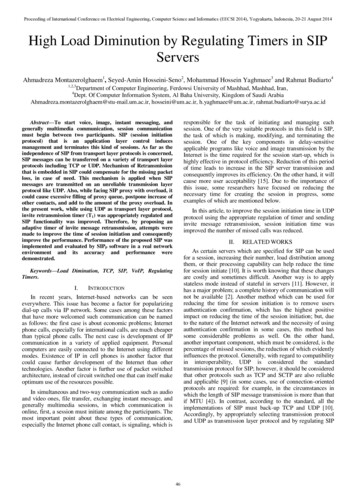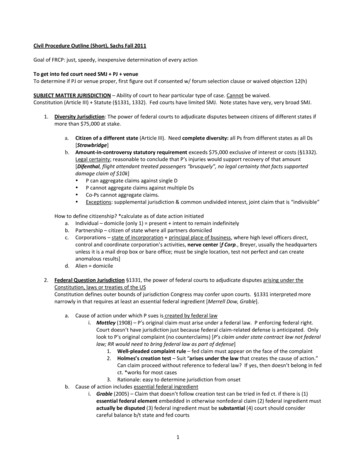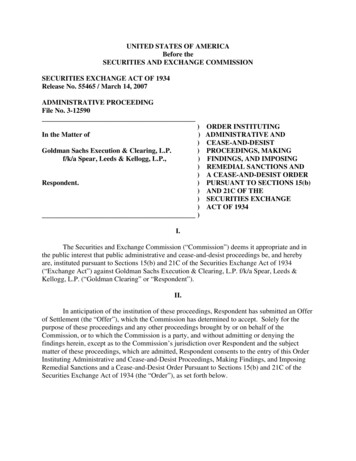
Transcription
UNITED STATES OF AMERICABefore theSECURITIES AND EXCHANGE COMMISSIONSECURITIES EXCHANGE ACT OF 1934Release No. 55465 / March 14, 2007ADMINISTRATIVE PROCEEDINGFile No. 3-12590)))Goldman Sachs Execution & Clearing, L.P.)f/k/a Spear, Leeds & Kellogg, L.P.,)))Respondent.)))))In the Matter ofORDER INSTITUTINGADMINISTRATIVE ANDCEASE-AND-DESISTPROCEEDINGS, MAKINGFINDINGS, AND IMPOSINGREMEDIAL SANCTIONS ANDA CEASE-AND-DESIST ORDERPURSUANT TO SECTIONS 15(b)AND 21C OF THESECURITIES EXCHANGEACT OF 1934I.The Securities and Exchange Commission (“Commission”) deems it appropriate and inthe public interest that public administrative and cease-and-desist proceedings be, and herebyare, instituted pursuant to Sections 15(b) and 21C of the Securities Exchange Act of 1934(“Exchange Act”) against Goldman Sachs Execution & Clearing, L.P. f/k/a Spear, Leeds &Kellogg, L.P. (“Goldman Clearing” or “Respondent”).II.In anticipation of the institution of these proceedings, Respondent has submitted an Offerof Settlement (the “Offer”), which the Commission has determined to accept. Solely for thepurpose of these proceedings and any other proceedings brought by or on behalf of theCommission, or to which the Commission is a party, and without admitting or denying thefindings herein, except as to the Commission’s jurisdiction over Respondent and the subjectmatter of these proceedings, which are admitted, Respondent consents to the entry of this OrderInstituting Administrative and Cease-and-Desist Proceedings, Making Findings, and ImposingRemedial Sanctions and a Cease-and-Desist Order Pursuant to Sections 15(b) and 21C of theSecurities Exchange Act of 1934 (the “Order”), as set forth below.
III.On the basis of this Order and Respondent’s Offer, the Commission finds that:Summary1.From at least March 2000 to May 2002 (the “relevant period”), certain customersof Goldman Clearing who used the firm’s direct market access, automated trading systemunlawfully sold securities short in advance of follow-on and secondary offerings in their primebroker accounts by, among other means, falsely marking their orders to sell “long.” Thecustomers’ pattern of illegal sales went undetected by Goldman Clearing, which reliedexclusively on the representations made by its customers concerning their positions in securitiesat the time of sale. Goldman Clearing’s exclusive reliance on its customers’ representations wasunreasonable. The customers’ pattern of trading and other information in Goldman Clearing’spossession reflected that the customers were selling the offered securities short. Had GoldmanClearing instituted and maintained procedures reasonably designed to detect any significantdisparity between its customers’ pattern of trading and the manner in which they marked theirorders to sell, it could have discovered that its trading and clearance records revealed the patternof unlawful trades effected by its customers. Goldman Clearing also could have discovered thatit was improperly lending the customers borrowed and proprietary securities to make deliverieson their purported long sales and closing their short positions with securities that they purchasedin follow-on and secondary offerings. Accordingly, Goldman Clearing did not have a reasonablebasis to believe its customers’ representations that they were “long” the securities they wereselling and, therefore, violated the Commission’s short sale rules and was a cause of itscustomers’ violations of the rules, as described below.Respondent2.Goldman Clearing is a limited partnership based in Jersey City, New Jersey andhas been registered with the Commission as a broker-dealer since 1948. Goldman Clearing wasformerly known as Spear, Leeds & Kellogg L.P. (“Spear”). In October 2000, The GoldmanSachs Group, Inc. acquired control of Spear by purchasing SLK LLC, Spear’s general partner.On January 14, 2005, the Spear name was changed to Goldman Clearing. Goldman Clearingprovides customers with, among other things, direct market access, automated trading and primebroker and stock loan and stock borrow services.2
The Selling Customers’ Trading Strategy3.From at least March 2000 to May 2002, certain customers of Goldman Clearingemployed a trading strategy that involved selling securities short, including securities listed onthe New York Stock Exchange, in advance of follow-on and secondary offerings and coveringtheir short sales with securities that they bought in the offerings (the “Selling Customers”).1 Byselling in advance of the offerings, the Selling Customers sought to take advantage of anticipateddeclines in the market prices of the securities in the days prior to the offerings. Typically, thepurchase prices for the offered securities were fixed at, or at a discount to, the closing prices forthe stock on the dates before the offerings commenced. The Selling Customers profited whenthey sold the securities short at prices that were higher than the offering prices set by the marketand that they subsequently paid to purchase the covering stock in the offerings. By engaging inthis trading strategy, the Selling Customers frequently covered short sales that they made withinfive days of the pricing of the offerings in contravention of Rule 105 of Regulation M. TheSelling Customers also frequently effected their short sales on “minus ticks” (i.e., at prices belowthe prices at which the securities were last sold) and “zero-minus ticks” (i.e., at the same prices atwhich the securities were last sold, but lower than the prices of the next preceding sales executedat different prices) in contravention of Section 10(a) of the Exchange Act and Rule 10a-1(a)thereunder.4.The Selling Customers carried out their trading strategy in prime broker accountsthat they maintained at Goldman Clearing as follows. Although they were selling the offeredsecurities short, the Selling Customers repeatedly effected their sales as long transactions bysubmitting their orders for execution through Goldman Clearing’s direct market access,automated trading platform, the REDI System (“REDI”). Using REDI, the Selling Customersprepared their own orders to sell on computer terminals and falsely marked them “long.” Theorders were routed through REDI directly to the New York Stock Exchange and other marketsfor execution. After being informed by REDI that their sales had been executed, the SellingCustomers frequently covered their sales by purchasing securities in follow-on and secondaryofferings in transactions executed away from Goldman Clearing and had the offered securitiesdelivered into their prime broker accounts (the “cover stock”). The cover stock was deliveredinto the Selling Customers’ accounts though the Institutional Delivery System.1During the relevant period, Rule 3b-3 under the Exchange Act defined a short sale as “any sale of a securitywhich the seller does not own or any sale which is consummated by the delivery of a security borrowed by, or forthe account of, the seller.” In July 2004, the Commission amended the short sale rules by adopting Regulation SHOand Rule 200(a) of the new regulation replaced Rule 3b-3. See Short Sales, Securities Exchange Act Release No.50103 (Jul. 28, 2004). However, the definition of a short sale generally did not change. Regulation SHO becameeffective in January 2005.3
Goldman Clearing did not Have a Reasonable Basis to Believe its Customers’Representations That They Were “Long” the Securities They Were Selling5.During the relevant period, Section 10(a) of the Exchange Act and Rule 10a-1(d)thereunder, provided that a broker could mark an order to sell a security registered, or admittedto unlisted trading privileges, on a national securities exchange “long” only if: (a) the security tobe delivered after sale was carried in the account in which the sale was to be effected or (b) thebroker had been informed that the seller owned the security ordered to be sold and, as soon aspossible and without undue inconvenience or expense, would deliver the security owned to theaccount for which the sale was to be effected. In addition, Section 10(a) of the Exchange Actand Rule 10a-2 thereunder, prohibited brokers from lending, or arranging for the loan of, anysecurity registered on a national securities exchange for delivery to the broker for the purchaserafter sale if the broker or dealer knew or had reasonable grounds to believe that the sale waseffected pursuant to an order marked “long” unless the broker knew, or had been informed by theseller, that: (a) the security sold had been forwarded to the seller’s account, or (b) the sellerowned the security sold and that it was then impracticable to deliver the security and that itwould be delivered to the seller’s account as soon as possible without undue inconvenience orexpense. Accordingly, broker-dealers, including Goldman Clearing, had to have a reasonablebasis to believe their customers’ representations that they were “long” the securities they wereselling.26.From at least March 2000 to May 2002,Goldman Clearing relied exclusively onthe representations made by its customers whether they were selling securities “long” or “short”when they did not have the securities in their accounts at the time of sale. In particular, GoldmanClearing relied on agreements that it entered into with each of its customers that provided that adesignation of a sell order as “long” was a representation that the customer owned the securitiesbeing sold. Consequently, when the Selling Customers marked their orders to sell “long,”Goldman Clearing presumed that the Selling Customers owned the securities. It did not takefurther steps following execution to detect whether the Selling Customers’ representations mightbe false, as discussed below.2Upon the adoption of Regulation SHO, Rule 10a-1(d) and Rule 10a-2 were removed and replaced byprovisions in the new regulation. Rule 10a-1(d) was replaced by Rule 200(g)(1) of Regulation SHO which permits abroker to mark an order to sell “long” only if the security being sold is owned by the seller and “either . . . (i) thesecurity to be delivered is in the physical possession or control of the broker . . . ; or (ii) it is reasonably expectedthat the security will be in the physical possession or control of the broker . . . no later than the settlement of thetransaction.” 17 CFR 242.200(g)(1). Rule 203(a) of Regulation SHO, which replaced Rule 10a-2, states in section(1) that “i[f] a broker or dealer knows or has reasonable grounds to believe that the sale of an equity security was orwill be effected pursuant to an order marked ‘long,’ such broker or dealer shall not lend or arrange for the loan ofany security for delivery to the purchaser’s broker after the sale, or fail to deliver a security on the date delivery isdue.” 17 CFR 242.203(a)(1). Section (2) of that rule states, however, that a broker or dealer may lend or arrange forthe loan of a security to make delivery on a long sale “[i]f the broker or dealer knows, or has been reasonablyinformed by the seller, that the seller owns the security, and that the seller would deliver the security to the broker ordealer prior to the scheduled settlement of the transaction, but the seller failed to do so.” 17 CFR 242.203(a)(2)(ii).Under Rules 200(g)(1) and 203(a), brokers remain obligated to have reasonable grounds to believe their customers’representations that they are “long” the securities that they are selling.4
7.During the relevant period, Goldman Clearing’s own records containedinformation about consummated transactions that reflected that the Selling Customers wereengaged in a pattern of selling securities short and that they were misrepresenting their “short”sales as “long” sales. Specifically, Goldman Clearing’s records contained information thatreflected the Selling Customers were repeatedly failing to deliver to Goldman Clearing thesecurities that they purported to sell long, and that the Selling Customers were purchasingsecurities in follow-on and secondary offerings away from Goldman Clearing and deliveringthose securities into their prime broker accounts to cover their sales. In addition, GoldmanClearing’s records contained information reflecting it was improperly lending the SellingCustomers securities to make deliveries on their purported long sales and closing their shortpositions with the cover stock that they purchased in the offerings.8.In its capacity as prime broker, Goldman Clearing received certain confirmationsfrom the brokers from whom the Selling Customers purchased the cover stock indicating that thecover stock were offered securities (the “Confirmations”). The Confirmations indicated that thecover stock were syndicate securities and that the transactions in which the Selling Customershad purchased the cover stock had extended settlement dates typical for transactions involvingsecurities offered in follow-on and secondary offerings. The Confirmations also indicated thatthe purchases made by the Selling Customers were subject to the closing of the offerings and thatthe Selling Customers had received prospectuses.9.Goldman Clearing used the information contained in the Confirmations to postthe purchase transactions effected by the Selling Customers to its trading records, including itsClearance Activity and Daily Margin Reports. The Clearance Activity Report reflected theSelling Customers’ daily positions in securities. On the days it received the Confirmations,Goldman Clearing’s Clearance Activity Report showed that the Selling Customers held shortpositions in the offered securities because they had sold the securities into the market within thefive business days preceding the offerings and did not have the securities in their accounts at thetime of sale. Goldman Clearing’s Daily Margin Report also reflected the Selling Customers’short positions in the offered securities. Goldman Clearing closed the short positions the SellingCustomers’ held in the offered securities by posting the cover stock the Confirmations indicatedthey purchased to its Clearance Activity and Daily Margin Reports.10.Because the Selling Customers covered their unlawful short sales by purchasingsecurities in the offerings, Goldman Clearing never had possession of the cover stock on the daysthat it had to settle such sales transactions (the “settlement dates”). Goldman Clearing onlyreceived the cover stock when the offerings settled and the offerings typically settled at least aday after the settlement dates for the sales. Rather than fail the sales made by the SellingCustomers, however, Goldman Clearing delivered borrowed and proprietary securities to thebrokers for the purchasers to settle the transactions. As a consequence, on the settlement dates,Goldman Clearing’s Daily Stock Record, which showed the firms’ daily positions in securities,contained information that reflected the short sales made by the Selling Customers. Specifically,the Daily Stock Record showed the Selling Customers held short positions in the offeredsecurities that were offset by long positions in the offered securities in Goldman Clearing’s stockborrow and proprietary accounts. Goldman Clearing closed the Selling Customers’ short5
positions on its Daily Stock Record after it paid the brokers who executed the purchasetransactions in full for the cover stock and it received the cover stock from them.11.Thus, for more than two years, Goldman Clearing’s records contained informationthat reflected the Selling Customers were falsely marking their REDI orders to sell “long.” Asreflected in Goldman Clearing’s records, the Selling Customers never delivered the securitiesthat they purported to sell long to Goldman Clearing. Rather, they frequently covered their salesby purchasing securities in follow-on and repeat offerings after they effected their salestransactions. In addition, Goldman Clearing always settled the Selling Customers’ sales withborrowed and proprietary securities and closed their short positions in the offered securities onlyafter it paid for and received the cover stock purchased by the Selling Customers. The SellingCustomers’ pattern of trading was therefore consistent with selling securities short and not longas they represented on their orders to sell.12.In light of the foregoing facts, Goldman Clearing’s exclusive reliance on theSelling Customers’ representations was unreasonable. The Selling Customers’ pattern of tradingand other information in Goldman Clearing’s possession reflected that the Selling Customerswere selling the offered securities short. Had Goldman Clearing instituted and maintainedprocedures reasonably designed to detect any significant disparity between its customers’ patternof trading and the manner in which they marked their orders to sell, it could have discovered thatits trading and clearance records contained information reflecting that the Selling Customerswere, in fact, falsely marking their REDI orders to sell “long” and selling securities short inviolation of Rule 105 of Regulation M and Section 10(a) of the Exchange Act and Rule 10a-1(a)thereunder. In addition, Goldman Clearing could have discovered that it was improperly lendingthe Selling Customers borrowed and proprietary securities to make deliveries on their purportedlong sales and closing their short positions with offered securities.Violations13.As a result of the conduct described above, Goldman Clearing willfully3 violatedSection 10(a) of the Exchange Act and Rule 10a-1(d) thereunder, which, during the relevantperiod, prohibited a broker or dealer, directly or indirectly, by use of the means andinstrumentalities of interstate commerce, and of the mails, and of any facility of any nationalsecurities exchange, from marking any order to sell a security registered on, or admitted tounlisted trading privileges on, a national securities exchange “long” unless (1) the security to bedelivered after sale was carried in the account for which the sale was to be effected, or (2) suchbroker or dealer was informed that the seller owned the security ordered to be sold and, as soonas was possible without undue inconvenience or expense, would deliver the security owned tothe account for which the sale was to be effected.14.As a result of the conduct described above, Goldman Clearing willfully violatedSection 10(a) of the Exchange Act and Rule 10a-2 thereunder, which, during the relevant period,prohibited a broker or dealer, directly or indirectly, by use of the means and instrumentalities of3“Willfully,” as used in the Order, means intentionally committing the act that constitutes the violation. SeeWonsover v. SEC, 205 F.3d 408, 414 (D.C. Cir. 2000); Tager v. SEC, 344 F.2d 5, 8 (2d Cir. 1965). There is norequirement that the actor also be aware that it is violating one of the Rules or Acts.6
interstate commerce, and of the mails, and of any facility of any national securities exchange,from lending, or arranging for the loan of any security registered, or admitted to unlisted tradingprivileges, on a national securities exchange for delivery to the broker for the purchaser aftersale, or from failing to deliver a security on the date delivery was due if such broker or dealerknew or had reasonable grounds to believe that the sale was effected, or would be effected,pursuant to any order marked “long” unless such broker or dealer knew or had been informed bythe seller, (1) that the security sold had been forwarded to the account for which the sale waseffected, or (2) that the seller owned the security sold, that it was then impracticable to deliver tosuch account the security owned and that he would deliver such security to such account as soonas it was possible without undue inconvenience or expense.15.As a result of the conduct described above, Goldman Clearing was a cause of theSelling Customers’ violations of Section 10(a) of the Exchange Act and Rule 10a-1(a)thereunder, which prohibit any person for his own account, directly or indirectly, by use of
automated trading platform, the REDI System (“REDI”). Using REDI, the Selling Customers prepared their own orders to sell on computer terminals and falsely marked them “long.” The orders were routed through REDI directly to the


